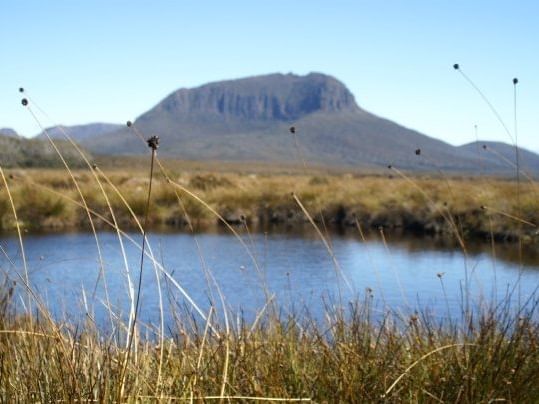Buttongrass Moors
Tasmania’s moorlands are found in the protected wilderness of the state’s west. Moorlands are wet environments, dominated by low-growing rushes and grass-like sedges, the most common of which is buttongrass (Gymnoschoenus sphaerocephalus). Buttongrass moors are found throughout Cradle Mountain-Lake St Clair National Park and occupy around one million hectares of land across Tasmania.
Buttongrass is one of the most common sedges found in western Tasmania. Named for the small round flower heads that sit at the tips of the plant’s long fronds, buttongrass thrives in wet, poorly drained environments, such as the peaty sub-alpine moors of Cradle Mountain-Lake St Clair National Park.
While buttongrass is often the dominant plant in a moorland area, many other plant species are also found here, including a several types of sedges, rushes, and mosses and ferns with evolutionary links to plants that grew on the Gondwanan supercontinent 100 million years ago.
Buttongrass burning
Buttongrass forms dense clumps, or tussocks, from which its characteristic button-tipped fronds protrude. In spite of its wet environment, buttongrass is highly susceptible to fire. As the plant grows, dead foliage accumulates and is retained in a dense, dry tussock—perfect fuel for a bushfire. However, the plant is well adapted to fire and regenerates quickly, with new shoots emerging from the base of the plant soon after burning.
Bushfire events can actually help to preserve buttongrass moorland, by preventing the establishment of other, potentially invasive forest species.
Animals of the buttongrass moors
The extremely wet conditions in buttongrass moors create the perfect habitat for a species of endemic burrowing crayfish (parastacoides tasmanicus), which has formed a special relationship with the plant. The crayfish digs burrows at the base of a buttongrass plant, and feeds on its fleshy rhizomes underground. This in turn aerates the soil, which benefits the plant.
Other species that shelter in buttongrass moorlands include several species of frogs and skinks, tiger snakes, white lipped snakes, countless insects, and mammals—such as the native broad-toothed mouse and velvet-furred rat. Other visitors include Bennetts wallabies, pademelons, wombats, quolls and many species of birds, including the rarely-seen ground parrot.
Where to see buttongrass
You can see buttongrass moorland as you explore Cradle Mountain, including at the Enchanted Walk alongside Pencil Pine Creek. It’s also commonly seen growing up to the roadside in many areas of western Tasmania, so keep watch for it as you drive throughout the region.
